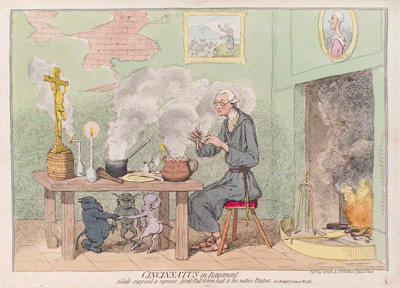Cincinnatus in Retirement...
This print portrays an unhappy, potato-peeling Edmund Burke. It takes its title from Cincinnatus, the Roman statesman who, according to the Encyclopedia Britannica, "gained fame for his selfless devotion to the republic in times of crisis and for giving up the reins of power when the crisis was over." Burke had recently and voluntarily left the Shelburne administration with Charles James Fox, refusing to be part of an administration whose policies he could not support.
In contrast to the resignation of Fox which he consistently portrays as motivated by rebellion and ambition, Gillray seems initially to place Burke in the role of the patriot, deprecating power for principle. But while he is willing to ascribe better motives than Fox's to Burke's resignation, Gillray abbors the principles of the "Romish Common-Wealth" which he suspects Burke wants to establish. Following upon Crumbs of Comfort which had portrayed Burke as a crypto-Catholic, Gillray shows Burke "in Retirement" surrounded by every possible sign and symbol of Irish Catholicism.

© National Portrait Gallery, London
The room is sparsely furnished with a plain wooden table and a three legged stool like a Catholic monk's cell. The brick work is showing through the plaster suggesting poverty. Smoke rises from a guttering fire, steaming pots, and a broken candle, perhaps suggestive of the haze of superstition.
On the walls are pictures of St. Boniface and Saint Brendan. Boniface was an Anglo-Saxon missionary and (like Burke as Gillray would have one believe) a chief supporter of the papacy. Brendan was an Irish monk who (like Burke) was reputed to be a great orator. In Brendan's case (so the legend goes) such was his power that the dolphins gathered to hear him speak and only dispersed after he concluded his sermon.
Burke is shod and attired like Saint Brendan in monk's sandals and a complete monastic habit with rope cincture from which hangs a rosary. He is eating a simple ascetic meal of (presumably Irish) potatoes from a chamber pot absurdly labeled "Relick No. 1 used by St. Peter."
Upon the table are a cask of Irish whiskey, devotional candles (broken) a crucifix (also broken), and birch rods for flagellation. Beneath the table are three impish devils, celebrating this (to Gillray) consummate perversion of religious belief.
The print with its enclosing walls and numerous defining objects shows that Gillray had studied Hogarth to good effect. But while Hogarth's central figures are types of a moral condition, Gillray's are beginning to be relentlessly personal.
Sources and Reading
- Commentary from the British Museum on Cincinnatus in Retirement...
- Who Was Saint Brendan
- Nicholas K Robinson, Edmund Burke: A Life in Caricature, 1996
Comments & Corrections
NOTE: Comments and/or corrections are always appreciated. To make that easier, I have included a form below that you can use. I promise never to share any of the info provided without your express permission.